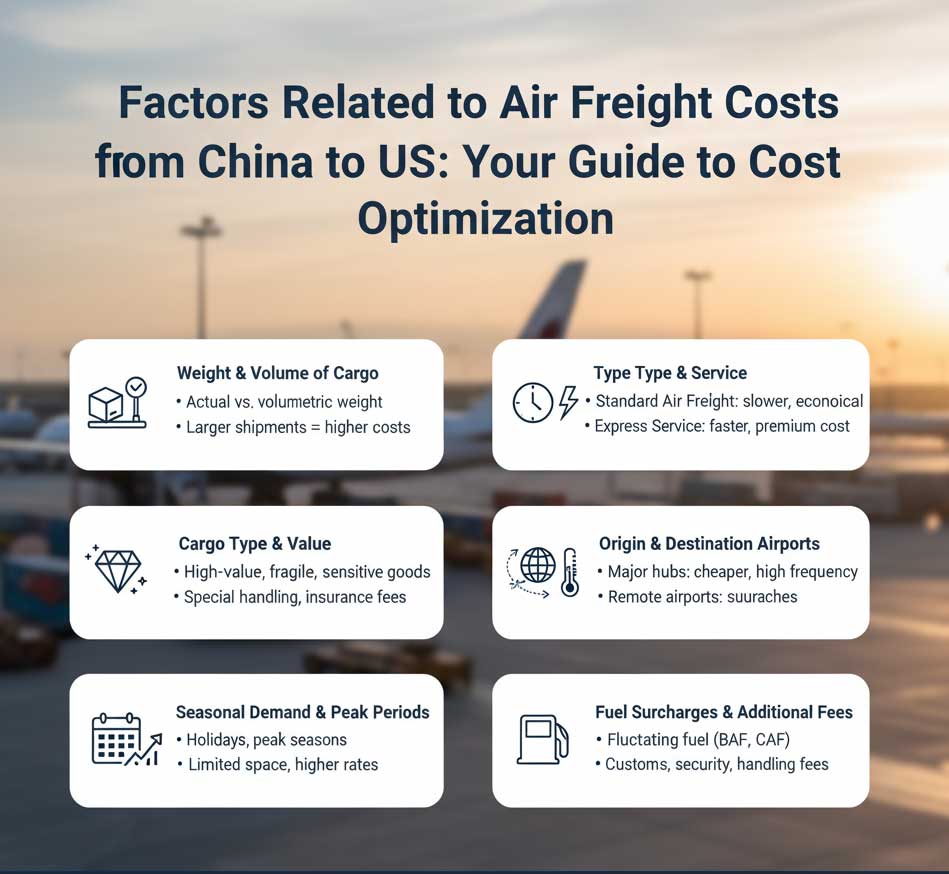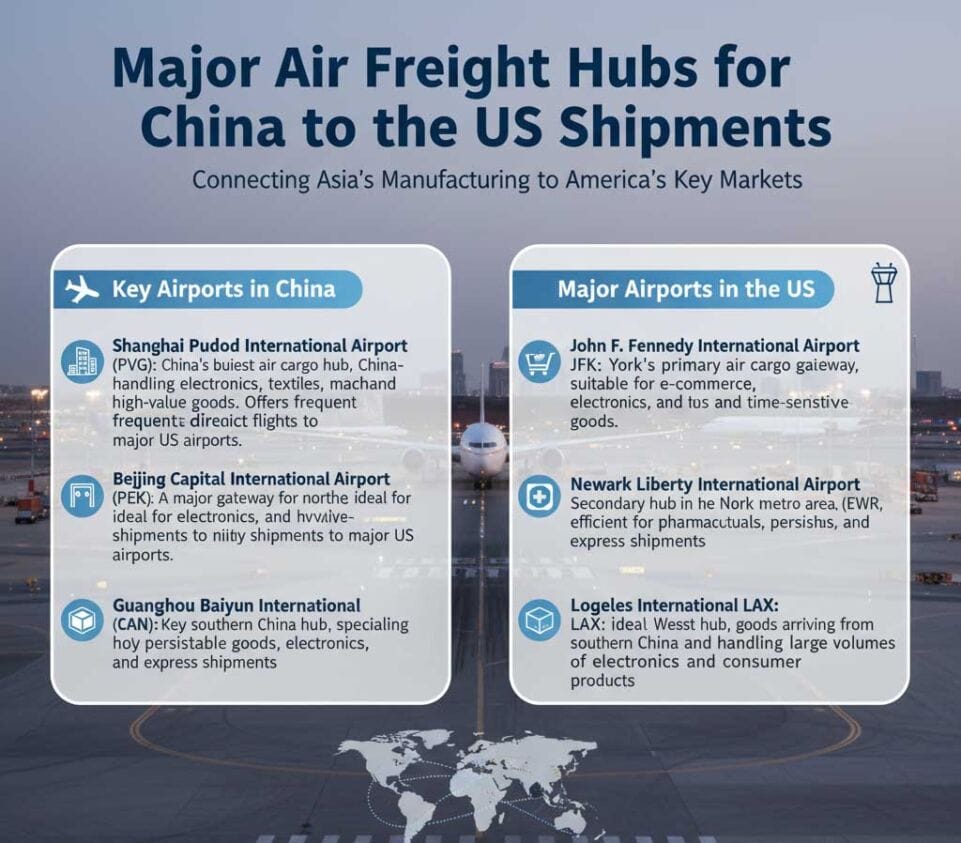Air freight from China to the US is one of the fastest and most reliable ways to move goods across the globe. With trade between the two countries remaining at the heart of international commerce, businesses rely on air shipping to ensure speed, security, and efficiency. Whether you’re a small importer seeking quick delivery of high-demand products or a large corporation managing time-sensitive cargo, air freight offers unmatched advantages compared to other transport methods. For many companies, air freight plays a key role in Shipping from China to US, helping them stay competitive in a fast-paced market.
Understanding the process, costs, transit times, and customs requirements is essential for making informed decisions and keeping your supply chain smooth. In this article, we’ll walk you through everything you need to know about air freight from China to the US, covering costs, procedures, benefits, and practical tips. Keep reading to discover how you can make your shipping process faster, safer, and more cost-effective.
August 2025 Air Freight Shipping Update: China → US
Here’s the latest average market rates and transit times for shipments from China to US (August 2025):
Costs
- Standard Air Freight (General Cargo): approximately $4.50 – $5.50 per kg
- Express Service: approximately $6.00 – $8.00 per kg
- Heavy & Oversized Cargo: special rates based on weight and volume (usually lower per kg, but with additional charges for occupied space)
- Sensitive Cargo (Dangerous Goods / Perishable / High-Value): includes extra safety and permit fees, generally higher than standard rates
- Additional Charges (Surcharges): includes fuel surcharge, insurance, storage, and customs fees at the destination
Delivery Times
| Type of Air Freight | Typical Delivery Time | Notes |
|---|---|---|
| Standard Cargo | 5–10 days | Economical option for most shipments |
| Express Service | 2–5 days | Faster delivery for urgent shipments |
| Heavy & Oversized Cargo | 7–14 days | Charges depend on weight & volume |
| Sensitive Cargo (Dangerous / Perishable / High-Value) | 3–7 days | Extra safety & permit fees apply |
Complete Guide to Air Freight Options from China to the US

1. Standard Cargo
Definition: Used for regular, non-sensitive goods and is the most cost-effective option for most shippers.
Advantages:
- Low and economical cost
- Suitable for non-urgent shipments
Disadvantages:
- Longer delivery time (5–10 days)
- Limited tracking options compared to express service
2. Express Service
Definition: Ideal for urgent or time-sensitive shipments that require fast delivery.
Advantages:
- Fast delivery (2–5 days)
- Reliable for critical or seasonal goods
Disadvantages:
- Higher cost than standard
- Weight and volume restrictions for packages
3. Heavy & Oversized Cargo
Definition: For goods exceeding standard weight or volume limits.
Advantages:
- Allows transportation of bulky and heavy goods
- High safety for large shipments
Disadvantages:
- Requires extra planning and coordination
- Possible additional charges for storage and handling
- Longer delivery time (7–14 days)
4. Sensitive Cargo (Dangerous, Perishable, or High-Value Goods)
Definition: For goods that require special safety measures, controlled temperature, or permits.
Advantages:
- Ensures safety and proper conditions for sensitive items
- Full insurance coverage
- Reasonable delivery time (3–7 days)
Disadvantages:
- Higher cost due to safety requirements and permits
- Requires precise documentation and additional coordination
5. Additional Charges (Surcharges)
Definition: Extra costs added to the base rate, including fuel, insurance, storage, and customs fees.
Advantages:
- Guarantees shipment safety
- Facilitates smooth customs clearance and handling
Disadvantages:
- Costs can vary and affect the overall budget
- May increase total shipping expenses
Air Freight from China to USA Time
Standard air freight from China to the US usually takes 5–14days, while express services can deliver in just 2–5 days. Delivery times depend on factors such as destination, customs clearance, flight schedules, and accurate documentation.
Weekends, holidays, and shipment declaration procedures can also affect transit times. Ensuring complete and correct paperwork, including precise shipper details and declared values, helps avoid delays.
Different airlines offer a variety of services depending on the origin city in China and the destination airport in the US. The table below compares typical air freight services and transit times for major routes.
| Departure Airport | Destination Airport | Transit Time | FOB Price (USD/KG) | Minimum Order |
|---|---|---|---|---|
| Shenzhen | Miami | 1 – 4 days per route | $4.2 – $4.8 | 45 KG |
| Shenzhen | Oakland | 7 days | $1 – $6 | 1 KG |
| Shenzhen | Atlanta | 3 – 4 days per route | $4.2 – $4.8 | 45 KG |
| Shenzhen | Boston | 3 – 4 days per route | $4.2 – $4.8 | 45 KG |
| Shenzhen | Washington | 3 – 4 days per route | $4.2 – $4.8 | 45 KG |
| Shenzhen | San Francisco | 1 – 4 days | $1 – $10 | 45 KG |
| Shenzhen | Detroit | 3 – 4 days per route | $4.2 – $4.8 | 45 KG |
| Shenzhen | Memphis | 3 – 4 days per route | $4.2 – $4.8 | 45 KG |
| Beijing | Detroit | 3 – 4 days per route | $4.2 – $4.8 | 45 KG |
| Guangzhou | Miami | 4 hours | $3.85 – $4.5 | 45 KG |
Air Freight from China to USA Cost (Updated 2025)
| Weight Range (KG) | Service Type | Rate per KG (USD) | Note |
|---|---|---|---|
| Standard | Air Freight | $3.3 | Standard air freight rate from China to US. |
| 0.5 – 5.5 | Air Express Freight | $4.65 – $17.36 | For lightweight packages sent via air express. |
| 6 – 11 | Air Express Freight | $9.82 – $15.73 | Cost-effective for mid-weight air express shipments. |
| 20.58 | Air Express Freight | $14.61 | An example package of 20.58KG would cost around $280 total. |
| 21 – 70 | Air Express Freight | $7 – $7.8 | For heavier shipments over 21KG, with slightly lower rates. |
| Over 70 | Air Express Freight | $6.5 – $7.2 | The best rates are reserved for the heaviest shipments. |
Air Freight Price Table per KG
| Weight Range (KG) | Service Type | Rate per KG (USD) | Notes |
|---|---|---|---|
| 0.5 – 5 | Air Express Freight | $4.65 – $17.36 | Lightweight packages with fast delivery |
| 6 – 11 | Air Express Freight | $9.82 – $15.73 | Mid-weight shipments at cost-effective rates |
| 12 – 20 | Air Express Freight | $14.61 | Example: a 20KG package costs around $292 total |
| 21 – 70 | Air Express Freight | $7 – $7.8 | Heavier shipments with slightly lower per-KG rates |
| Over 70 | Air Express Freight | $6.5 – $7.2 | Best rates reserved for very heavy shipments |
How to Calculate the Cost of Air Freight Services from China ?
Air freight from China offers a fast and reliable solution for businesses dealing with lightweight or high-value goods, even though its base rates are typically higher than sea freight .
Although air shipments account for only around 5% of import volume, they represent nearly 30% of total import value.
This premium is justified for products like luxury electronics, delicate apparel, or essential pharmaceuticals, where speed, security, and careful handling are critical.
For heavier or bulkier items such as furniture, textiles, or industrial equipment, air freight can become prohibitively expensive.
In these cases, ocean freight where costs are primarily calculated based on weight and volume usually provides a more cost-effective alternative.
When deciding between air and sea freight, it is essential to carefully consider both the weight and dimensions of your cargo.
Consulting with an experienced freight forwarder can help you choose the most economical and efficient shipping method tailored to your specific business needs.
What factors are related to air freight costs from China to Us?

Weight and Volume of Cargo
Air freight charges are calculated based on either actual weight or volumetric (dimensional) weight, whichever is higher. Larger or heavier shipments naturally incur higher costs.
Type of Service
Standard air freight is more economical but slower. Express services offer faster delivery for urgent shipments but at a higher price.
Cargo Type and Value
High-value, fragile, or sensitive goods (electronics, pharmaceuticals, perishable items) often require special handling or insurance, increasing the overall cost.
Origin and Destination Airports
Shipping to major hubs is usually cheaper due to higher flight frequency and capacity. Remote or less-serviced airports can lead to additional surcharges.
Seasonal Demand and Peak Periods
Costs can rise during peak shipping seasons, holidays, or periods of high trade activity due to limited cargo space and higher demand.
Fuel Surcharges and Additional Fees
Fluctuating fuel prices, customs clearance charges, security fees, and handling costs all contribute to the total shipping cost.
Freight Forwarder and Carrier Choice
Different carriers and forwarders offer varying rates, service options, and reliability, which can impact the final cost.
Air Freight Process from China to the US
Booking and Documentation
- The process begins by booking your shipment with a freight forwarder or airline.
- Essential documents include the commercial invoice, packing list, Air Waybill (AWB), and any required customs paperwork. Accurate documentation ensures smooth clearance and reduces delays.
Cargo Preparation and Packaging
- Goods must be properly packed to withstand handling, pressure changes, and transit.
- Sensitive, fragile, or high-value items may require special packaging, labeling, or temperature control.
Customs Export Clearance in China
- The shipment must pass Chinese customs.
- Customs checks documents, ensures proper duties are paid, and inspects goods if necessary.
Transport to the Airport and Loading
- Cargo is transported to the departure airport.
- It is weighed, measured, and loaded onto the aircraft according to airline safety and weight distribution rules.
Air Transport
- The goods are flown to the destination airport in the US.
- Flight duration depends on service type (standard or express) and any layovers or connecting flights.
US Customs Clearance
- Upon arrival, shipments go through US customs.
- Proper documentation, correct product classification, and accurate declared values are crucial to avoid delays or additional fees.
Delivery to the Final Destination
- After customs clearance, cargo is transported to the consignee’s warehouse or delivery address.
- Some freight forwarders also offer door-to-door services to simplify the process..
Common Incoterms for Air Freight from China to the US
| Incoterm | Seller Responsibility | Buyer Responsibility | Notes / Suitable For |
|---|---|---|---|
| EXW (Ex Works) | Goods made available at seller’s premises | All transport, customs clearance, and shipping costs | Suitable for experienced importers who can manage logistics |
| FOB Incoterm(Free On Board) | Deliver goods to departure airport and load onto aircraft | International transport, customs, and delivery costs | Common for standard shipments to US ports and airports |
| CIF incoterm/ CIP (Cost, Insurance & Freight / Carriage and Insurance Paid) | Shipping, insurance, and freight charges to destination airport | Minimal; mainly receives goods at destination | Reduces buyer’s logistical burden; useful for high-value or sensitive cargo |
| DAP incoterm / DDP (Delivered at Place / Delivered Duty Paid) | DAP: Deliver to destination without import duties DDP: Deliver to destination including duties and shipping | DAP: Import duties DDP: Minimal; receives ready-to-use goods | Ideal for importers who want hassle-free, door-to-door delivery |
Prohibited and Restricted Items in Air Freight from China to the US
Shipping goods from China to the United States requires careful attention to US import regulations. Some items are strictly prohibited, while others are restricted and may need special permits, documentation, or packaging. Understanding these rules helps avoid delays, fines, or confiscation at customs.
To make shipping easier and fully compliant, we’ve created a clear Prohibited & Restricted Items table for US air freight, ensuring your shipments reach their destination smoothly and safely.
| Category | Items | Notes / Conditions |
|---|---|---|
| Prohibited Items | Explosives, fireworks, ammunition Flammable liquids and gases Radioactive materials Corrosive substances Narcotics and illegal drugs Weapons and firearms (without authorization) Items violating US trade or IP laws | Cannot be shipped under any circumstances; attempting to ship may result in seizure, fines, or legal action. |
| Restricted Items | Perishable goods (food, plants, flowers) Batteries (especially lithium-ion) Pharmaceuticals and medical supplies Alcohol and tobacco products Live animals | Can be shipped only under specific conditions, such as permits, special packaging, or airline approval. |
Major Air Freight Hubs for China to the US Shipments

Key Airports in China:
- Shanghai Pudong International Airport (PVG): China’s busiest air cargo hub, handling electronics, textiles, machinery, and high-value goods. Offers frequent direct flights to major US airports.
- Beijing Capital International Airport (PEK): A major gateway for northern China, ideal for electronics, machinery, and high-value shipments to the US.
- Guangzhou Baiyun International Airport (CAN): Key southern China hub, specializing in perishable goods, electronics, and express shipments.
Major Airports in the US:
- John F. Kennedy International Airport (JFK): New York’s primary air cargo gateway, suitable for e-commerce, electronics, and time-sensitive goods.
- Newark Liberty International Airport (EWR): Secondary hub in the New York metro area, efficient for pharmaceuticals, perishables, and express shipments.
- Los Angeles International Airport (LAX): West Coast hub, ideal for goods arriving from southern China and handling large volumes of electronics and consumer products.
Final Review
Air freight from China to the United States is the fastest and most reliable choice for businesses shipping high-value or time-sensitive goods. Although more costly than sea freight, it offers unmatched speed, security, and reduced risk of delays.
Understanding transit times, customs rules, Incoterms, and key air hubs helps importers plan better and avoid unexpected issues. Partnering with an experienced freight forwarder is the best way to ensure smooth customs clearance and timely delivery.
If you’re looking for a trusted partner, TopShipping provides efficient, secure, and cost-effective air freight solutions from China to the US—helping your business ship with confidence.
FAQs: Air freight to the US
How long does air freight from China to the US typically take?
Air freight usually takes 3–10 days, depending on the service type (express vs. standard) and the origin/destination airports.
What types of goods can be shipped by air?
Most goods, including electronics, apparel, perishables, and high-value items, can be shipped by air. Restricted items such as hazardous materials require special permits.
How is air freight charged?
Air freight charges are typically based on weight or volume (whichever is higher). Additional fees may apply for fuel surcharges, customs clearance, and insurance.
Can I track my shipment?
Yes, most freight forwarders and airlines provide real-time tracking so you can monitor your shipment from China to the US.
Do I need to handle customs myself?
No, a reputable freight forwarder like Topshipping handles customs documentation and clearance, ensuring your shipment moves smoothly and avoids delays.
What are the advantages of air freight over sea freight?
Air freight is much faster, making it ideal for urgent or high-value shipments, while sea freight is slower but more economical for large volumes.

